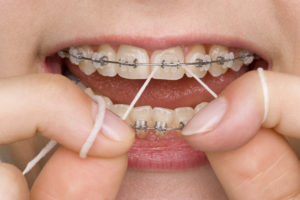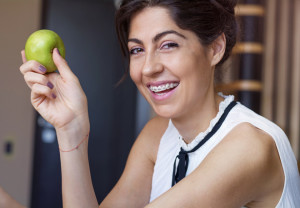When you have braces, it’s very important to brush and floss after every meal in order to keep your teeth and gums healthy throughout your treatment. If you need help choosing the right toothbrush, toothpaste, dental floss, or fluoride rinse, please ask us and we can help you choose the right products for your teeth and your appliance.


Place your toothbrush at a 45-degree angle to your gum.

Brush gently in a circular motion.

Brush the outer, inner, and chewing surfaces of each tooth.

Use the tip of your brush for the inner surface of your front teeth. After brushing, it’s a good practice to use a Waterpik to dislodge any remaining food particles or plaque, especially around the braces.
It is important that you wear your retainer as instructed by Dr. Kurt when you visit Niepraschk Orthodontics. Clean the retainer thoroughly – with warm but not hot water – at least once a day with a toothbrush. Cleaning them removes plaque and eliminates odors.
Be sure to remove your retainer before eating. Retainers are breakable, so treat yours with care. When your retainer is not in your mouth, it should be in its case.
Also, be sure to not leave it sitting in hot areas like a car or your pocket.
If your retainer gets broken or is lost, contact us immediately at (303) 978-1316. If you have any questions about your retainer in Littleton, Denver, or Highlands Ranch, CO, call us. Always bring your retainer to your appointments.

Using a piece of floss about 18 inches long, carefully thread the end between braces and wire. You may find a floss threader helpful.
Carefully floss around the braces.
Carefully floss around the gum areas.
Carefully floss around each tooth. Finishing up with a fluoride rinse after flossing can provide extra protection against cavities and help keep your teeth strong during your treatment.
Now that you have your braces, how do you take care of them?
You will need to avoid any foods that could damage your new appliances.
Avoid sticky and chewy foods (caramel, chewing gum, gummy bears), hard foods (hard candy, nuts, ice cubes), or any foods that could possibly get stuck in your braces (corn on the cob, soft bagels, ribs, taffy, etc.).
Be sure to schedule your routine checkups with your family dentist. It is recommended that you continue to visit the dentist every six months.

Waterpiks are convenient and effective tools for cleaning braces. Using a pulsating water stream, a Waterpik can help to dislodge food particles, plaque, and bacteria from between the brackets, wires, and teeth that are difficult to access with traditional brushing and flossing. This helps to reduce the risk of tooth decay and gum problems that are common during orthodontic treatment. By incorporating a Waterpik into your oral care routine, individuals with braces can ensure a more thorough and efficient cleaning process, promoting healthier gums and a brighter smile.
Using a fluoride rinse can be highly beneficial as you care for your braces. Braces create small crevices and spaces where plaque and food particles can accumulate, making them more prone to bacteria growth and tooth decay. Fluoride rinses act as an additional layer of defense, helping to prevent cavities and minimize the risk of white spots or decalcification during orthodontic treatment. With its ability to reach areas that regular brushing and flossing may miss, a fluoride rinse can enhance oral health while ensuring a brighter, healthier smile throughout your orthodontic journey.

soft cheese, pudding, milk-based drinks

soft tortillas, pancakes, muffins without nuts

pasta, soft cooked rice

soft cooked chicken, meatballs, lunch meats

tuna, salmon, crab cakes

mashed potatoes, steamed spinach, beans

applesauce, bananas, fruit juice

ice cream without nuts, milkshakes
When you first get your braces, your teeth and mouth may feel a little tender or sore. This is perfectly normal. To relieve the pain, we recommend dissolving one teaspoon of salt in eight ounces of lukewarm water. Swish and gargle this solution in your mouth for just a couple of minutes (do not swallow the saltwater).
If the pain does not go away after rinsing, you can also try putting wax over your braces. It’s not uncommon for your tongue, cheeks, and lips to be irritated as they toughen and become used to the braces. If the pain is still severe, take a mild pain reliever.
Your braces must first loosen your teeth to in order move them into the right position. Once your teeth have been re-positioned, they will no longer be loose.
If the wires and bands on your dental braces come loose, call us at (303) 978-1316 as soon as possible so that we can check and repair your appliance. If any piece of your appliance comes off, be sure to save it and bring it with you. You can temporarily fix the loose wire by using an eraser end of a pencil to carefully and gently push the wire back into place. If the loose wire is causing irritation to your lips or cheeks, put wax or a wet cotton ball over the broken wire to relieve the pain.
Damaged appliances can increase the length of your treatment process, so be sure to take care of all your appliances. Your teeth and jaw can only move into their correct positions if you consistently wear appliances as prescribed by your doctor.
You can still play sports even while undergoing orthodontic treatment! We just recommended that you wear a mouthguard to protect your teeth and your appliance. Let Dr. Kurt know if you need help selecting a mouthguard.
There’s never a better time to start your journey towards Your Smile For Life. Get started with scheduling a Free Consultation today at Niepraschk Orthodontics in Littleton.